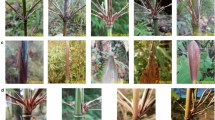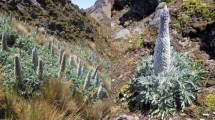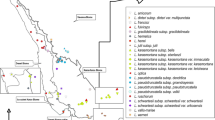Summary
An electrophoretic survey of genetic variation in 50 populations representing all ten taxa of section Inflexae of the plant genus Limnanthes is reported here with three objectives: 1) to describe genetic differentiation for testing certain phylogenetic hypotheses on the origin of species and infraspecific relationships, 2) to evaluate the concordance of electrophoretic, morphological and hybridization data within the section, and 3) to discuss models of speciation using Limnanthes as an example. Species, subspecies, and populations, designated on the basis of morphology and distribution, gave decreasing values of genetic distances that were apparently maintained across a wide ecological and geographical range. Using electrophoretic, morphological and hybrid fertility data, we concluded that L. montana, intermediate in range between the two disjunct varieties of L. gracilis, is not likely to be a relictual set of populations from what once was a continuously distributed taxon as hypothesized by earlier workers. Neither L.g. gracilis nor L.g. parishii appear to have been founded by long distance dispersal from one to the other. However, a very close genetic relationship was detected between L. gracilis and L. alba. This genetic pattern suggested that the two disjunct L. gracilis varieties were probably connected by a L. alba-like taxon and perhaps originated from that taxon. Evidence based on allozyme variation did not support the thesis that the inbreeder L. floccosa is a recent derivative from the outbreeder L. alba. Among the remaining five taxa (i.e. two varieties of L. gracilis, two varieties of L. alba, and L. montana), genetic distance and interspecific hybridization data are highly concordant, (r = -0.92, P < 0.001). The agreement of these two approaches with species relationships based on morphological similarity was less certain. Limnanthes species appear to exhibit greater interpopulation differentiation than many plant groups, perhaps a reflection of their distinctive island-like distribution pattern. On the other hand, an unusually high crossability is found in Limnanthes. Speciation in Limnanthes appears largely to follow a model of adaptive geographical divergence but certain other modes cannot yet be ruled out.
Similar content being viewed by others
References
Arroyo MTK (1973a) A taximetric study of infraspecific variation in autogamous Limnanthes floccosa (Limnanthaceae). Brittonia 25:177–191
Arroyo MTK (1973b) Chiasma frequency evidence on the evolution of autogamy in Limnanthes floccosa (Limnanthaceae). Evolution 27:679–688
Axelrod EI (1967) Geologic history of the Californian Insular Flora. In: Philbrik RN (ed) Proc Symp Biol California Islands. Santa Barbara Botanic Garden, Santa Barbara, Calif, pp 93–149
Ayala FJ, Tracy ML, Hedgecock D, Richmond RC (1974) Genetic differentiation during the speciation process in Drosophila. Evolution 28:576–592
Brown CR, Jain SK (1979) Reproductive system and pattern of genetic variation in two Limnanthes species. Theor Appl Genet 54:181–190
Crawford DJ (1982) Allozyme variation in Coreopsis nuecensoides and C. nucensis (Compositae), a progenitorderivative species pair. Evolution 36:379–386
Gottlieb LD (1973) Genetic differentiation, sympatric speciation and the origin of a diploid species of Stephanomeria. Am J Bot 60:545–553
Gottlieb LD (1981) Electrophoretic evidence and plant populations. Prog Phytochem 7:1–46
Grant V (1971) The origin of adaptations. Columbia, NY
Hauptli H, Webster BD, Jain SK (1978) Variation in nutlet morphology of Limnanthes. Am J Bot 65:615–624
Holland R, Jain SK (1977) Vernal pools. In: Barbour M, Major J (eds) Terrestrial vegetation of California. John Wiley, New York pp 251–305
Jain SK (1976) The evolution of inbreeding in plants. Ann Rev Ecol Syst 7:468–495
Jain SK, Hauptli H, Boussy I (1978) Male sterility in meadowfoam (Limnanthes douglasii var.‘nivea’). J Hered 69:61–63
Kesseli R, Jain SK (in preparation) A biosystematic study of the section Reflexae of plant genus Limnanthes
Levin DA (1978) The origin of isolating mechanisms in flowering plants. Evol Biol 11:185–317
Lewis H (1973) The origin of diploid neospecies in Clarkia. Am Nat 107:161–170
Lewontin RC (1974) The genetic basis of evolutionary change. Columbia, NY
Lloyd DG (1965) Evolution of self-compatibility and racial differentiation in Leavenworthia (Cruciferae). Contrib Gray Herb Harv Univ 195:3–134
McNeill C, Jain SK (in preparation) Variation in floral morphology, autofertility and breeding system in three Limnanthes taxa
McNeill C, Ritland K, Jain SK, Ganders FR (in preparation) A revision of the Limnanthes alba L. gracilis complex
Mason CT (1952) A systematic study of the genus Limnanthes. R Br Univ Calif Pub Bot 25:455–512
Maynard Smith J (1982) Evolution now. Freeman, San Francisco
Miller RG (1974) The jackknife — a review. Biometrika 61:1–15
Moore DM, Lewis H (1965) The evolution of self-pollination in Clarkia xanthiana. Evolution 19:104–114
Mueller LD (1979) A comparison of two methods for making statistical inferences on Nei's measure of genetic distance. Biometrics 35:757–763
Munz PA (1935) A manual of Southern California botany. Claremont College, Claremont, Calif
Nei M (1972) Genetic distance between populations. Am Nat 106:283–292
Nei M, Roychoudhury AK (1974) Sampling variances of heterozygosity and genetic distances. Genetics 76:379–390
Ornduff R (1971) Systematic studies of Limnanthaceae. Madrono 21:103–111
Ornduff R, Crovello TJ (1968) Numerical taxonomy of Limnanthaceae. Am J Bot 55:173–182
Parker WH (1980) Contrasting patterns of U.V. absorbance/reflectance of Limnanthes flowers. In: Scudder GGE, Reveal JL (eds) Proc 2nd Int Congr Sys Evol Biol, Vancouver, BC, p 304 (Abstract)
Raven PH (1976) Systematics and plant population biology. Syst Bot 1:284–316
Raven PH, Axelrod DI (1978) Origin and relationships of the California flora. Univ Calif Pub Bot 72:1–134
Raven PH, Gregory D (1972) A revision of the genus Gaura (Onagraceae). Mem Torrey Bot Club 23:1–96
Rick CM (1979) Evolution of interspecific barriers in Lycopersicon. In: Zeven AC, vanHarten AM (eds) Proc Conf Broadening Genet Base Crops. PUDOC, Wageningen, The Netherlands, pp 283–286
Rick CM, Kesicki E, Fobes JF, Holle M (1976) Genetic and biosystematic studies on two new sibling species of Lycopersicon from interandean Peru. Theor Appl Genet 47:55–68
Rick CM, Fobes JF, Tanksley SD (1979) Evolution of mating systems in Lycopersicon hirsutium as deduced from genetic variation in electrophoretic and morphological characters. Plant Syst Evol 132:279–298
Ritland K, Jain SK (in preparation) Parallel evidence for geographical variation in Limnanthes alba from morphological, electrophoretic and life history data. Oecologia (Berlin)
Singh RS, Hubby JL, Throckmorton LH (1975) The study of genic variation by electrophoretic and heat denaturation techniques at the octanol dehydrogenase locus in members of the Drosophila virilis group. Genetics 80:637–650
Small E (1971) The evolution of reproductive isolation in Clarkia, section Myxocarpa. Evolution 25:330–346
Sneath PHA, Sokal RR (1973) Numerical taxonomy. Freeman, San Francisco
Stebbins GL (1974) Flowering plants. Evolution above the species level. Harvard University Press, Cambridge, Mass
Stebbins GL (1976) Ecological islands and vernal pools of California. In: Jain SK (ed) Vernal pools their ecology and conservation. Institute of Ecology Publ No 9, University of California, Davis
Templeton AR, (1981) Mechanisms of speciation — a population genetic approach. Ann Rev Ecol Syst 12:23–48
Thorpe JP (1982) The molecular clock hypothesis: biochemical evolution, genetic differentiation and systematics. Ann Rev Ecol Syst 13:139–168
Wake DB (1981) The application of allozyme evidence to problems in the evolution of morphology. In: Scudder GGE, Reveal JL (eds) Evolution today, Proc Sec Int Congr Sys Evol Biol, pp 257–270
Wright S (1970) Random drift and the shifting balance theory of evolution. In: Kojima K (ed) Mathematical topics in population genetics. Springer, Berlin Heidelberg New York, pp 1–32
Author information
Authors and Affiliations
Additional information
Communicated by P.M.A. Tigerstedt
Rights and permissions
About this article
Cite this article
McNeill, C.I., Jain, S.K. Genetic differentiation studies and phylogenetic inference in the plant genus Limnanthes (section Inflexae). Theoret. Appl. Genetics 66, 257–269 (1983). https://doi.org/10.1007/BF00251156
Received:
Issue Date:
DOI: https://doi.org/10.1007/BF00251156




